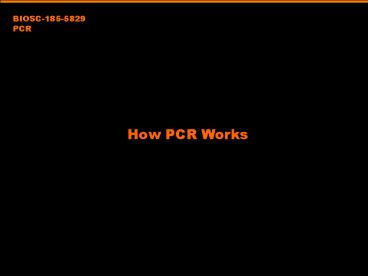How PCR Works - PowerPoint PPT Presentation
1 / 31
Title:
How PCR Works
Description:
Mixing Common Reagents Saves Time. Component 1X 20X. Sterile Water 38.0 ul 760 ul ... Typical Thermal Cycler Conditions. 1. Initial Denaturation 95 C 3 min ... – PowerPoint PPT presentation
Number of Views:133
Avg rating:3.0/5.0
Title: How PCR Works
1
How PCR Works
2
How PCR works
- Bio-Rad Animation
- Cold Spring Harbor Animation
- Animated .GIF files
3
Review The structure of DNA
Double Helix
Complementary Base Pairing
4
How PCR works
- Cold Spring Harbor Animation
5
How PCR works
- Bio-Rad PCR Animation
6
How PCR works
- Animated .GIF 1
7
How PCR works
- Animated .GIF 2
8
The PCR Reaction Chemistry
9
PCR Reaction Components
- Water
- Buffer
- DNA template
- Primers
- Nucleotides
- Mg ions
- DNA Polymerase
10
PCR Reaction Water
- Water
- The medium for all other components.
11
PCR Reaction Buffer
- Water
- Buffer
- Stabilizes the DNA polymerase, DNA, and
nucleotides - 500 mM KCl
- 100 mM Tris-HCl, pH 8.3
- Triton X-100 or Tween
12
PCR Reaction Template DNA
- Water
- Buffer
- DNA template
- Contains region to be amplified
- Any DNA desired
- Purity not required
- Should be free of polymerase inhibitors
13
PCR Reaction Primers
- Water
- Buffer
- DNA template
- Primers
- Specific for ends of amplified region
- Forward and Reverse
- Annealing temps should be known
- Depends on primer length, GC content, etc.
- Length 15-30 nt
- Conc 0.1 1.0 uM (pMol/ul)
14
PCR Reaction Primers
- Water
- Buffer
- DNA template
- Primers
Primer Binding Activity!
15
PCR Reaction Nucleotides
- Water
- Buffer
- DNA template
- Primers
- Nucleotides
- Added to the growing chain
- Activated NTPs
- dATP, dGTP, dCTP, dTTP
- Stored at 10mM, pH 7.0
- Add to 20-200 uM in assay
16
PCR Reaction Magnesium
- Water
- Buffer
- DNA template
- Primers
- Nucleotides
- Mg ions
- Essential co-factor of DNA polymerase
- Too little Enzyme wont work.
- Stabilizes the DNA double-helix
- Too much DNA extra stable, non-specific
priming, band smearing - Used at 0.5 to 3.5 uM in the assay
17
PCR Reaction Polymerase
- Water
- Buffer
- DNA template
- Primers
- Nucleotides
- Mg ions
- DNA Polymerase
- The enzyme that does the extension
- TAQ or similar
- Heat-stable
- Approx 1 U / rxn
18
PCR Reaction ComponentsReview
Summary
- Water
- Buffer
- DNA template
- Primers
- Nucleotides
- Mg ions
- DNA Polymerase
19
Setting Up PCR Reactions
20
A Typical PCR Reaction
Sterile Water 38.0 ul 10X PCR Buffer
5.0 ul MgCl2 (50mM) 2.5 ul dNTPs
(10mM each) 1.0 ul PrimerFWD (25 pmol/ul) 1.0
ul PrimerREV 1.0 ul DNA Polymerase
0.5 ul DNA Template 1.0 ul Total
Volume 50.0 ul
21
Mixing Common Reagents Saves Time
Component 1X 20X Sterile
Water 38.0 ul 760 ul 10X PCR Buffer
5.0 ul 100 ul MgCl2 (50mM)
2.5 ul 50 ul dNTPs (10mM each) 1.0 ul
20 ul PrimerFWD (25 pmol/ul) 1.0 ul 20
ul PrimerREV 1.0 ul 20 ul DNA
Polymerase 0.5 ul 10 ul DNA
Template 1.0 ul -- Total Volume
50.0 ul 980 ul
Aliquot 49 ul
Add DNA as last step
22
An Even Simpler ApproachMastermix
Sterile Water 10X PCR Buffer
MgCl2 dNTPs DNA Polymerase Primer FWD Primer
REV DNA Template
MASTERMIX 19.6 ul Sterile Water
10X PCR Buffer MgCl2 dNTPs DNA
Polymerase Primers FwdRev 0.4 ul DNA
Template 20.0 ul Total Volume
40.0 ul
23
Programming the Thermal Cycler
24
Typical Thermal Cycler Conditions
1. Initial Denaturation 95 C 3 min 2. DNA
Denaturation 94 C 1 min 3. Primer
Annealing 59 C 1 min 4. Primer Extension
72 C 1 min 5. Go to step 2, repeat 39
more times 6. End
25
Analyzing the Amplified DNA
26
PCRVisualizingResults
- After thermal cycling, tubes are taken out of the
PCR machine. - Contents of tubes are loaded onto an agarose gel.
- DNA is separated by size using an electric field.
- DNA is then stained.
- PCR products are visible as different bands.
27
PCRVisualizingResults
28
PCRVisualizingResults
Gel running
29
PCRVisualizingResults
After the gel has run, it is stained to reveal
the DNA bands
30
PCRVisualizingResults
The final result of the traditional PCR procedure
is a gel with a series of bands
Bands can be compared against each other, and to
known size-standards, to determine the presence
or absence of a specific amplification product.
31
(No Transcript)



























![Traveling Outside The US? Book RT PCR COVID Test for Travel in Dallas Area [Results Within 6 – 8 Hours] PowerPoint PPT Presentation](https://s3.amazonaws.com/images.powershow.com/9729047.th0.jpg?_=20220302046)



